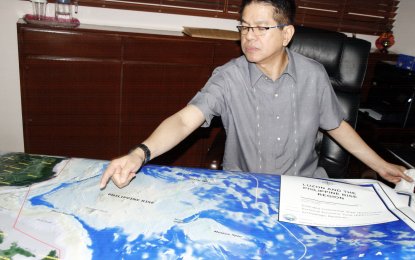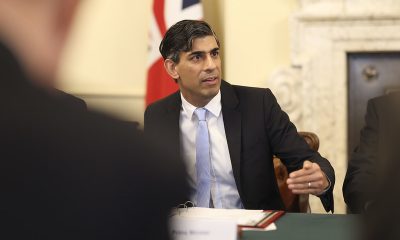Lifestyle
ECS of PH Rise, 11 years in the making

PH RISE. National Mapping and Resource Information Authority (NAMRIA) Deputy Administrator Efren Carandang talks about the Philippine Rise, formerly known as Benham Rise, in an interview with the Philippine News Agency. On May 16, the all-Filipino scientific research team is scheduled to visit the Philippine Rise, an important fishing ground for tuna fishermen from Infanta and Real in Quezon; Baler, Aurora; Catanduanes; and other adjacent provinces along the northern tip of the Philippines. (PNA photo by Noel D. Veloso)
MANILA — Did you know that the country’s first validated claim under the United Nations Convention on the Law of the Sea (UNCLOS), or the additional 118-nautical mile extended continental shelf (ECS) of the Philippines Rise took more than a decade for the country to hold?
The story of the country’s claim on Philippine Rise, known as Benham Rise, began with a workshop in 2001 to assist the Department of Foreign Affairs (DFA) and the Department of Environment and Natural Resources’s (DENR) National Mapping and Resource Information Authority (NAMRIA) on the implementation of then freshly ratified UNCLOS.
NAMRIA Deputy Administrator Efren Carandang told the Philippine News Agency (PNA) that the plateau, much more the potential ECS, during those times was a relatively unknown area of the Pacific Ocean east of Luzon, “a blank canvass.”
From 2004 to 2010, NAMRIA conducted a total of 23 survey cruises in the area, where they were able to discover saddles or connection in the natural prolongation of Luzon.
Carandang shared that experts who were studying the area back then warned NAMRIA the survey may be a lost cause.
“Sabi nila wala (nang makikita) because of the Philippine trench. What NAMRIA did is to survey every corner in the seabed,” he said. “Then we saw a saddle–a connection. It was deep, but it was a connection. At the Palanan saddle, it was the same, we established there was a connection.”
“So dati para lang siyang blank canvass, you can’t imagine how it looked. It’s through our surveys that we were able to figure out the configuration of Benham Rise.”
The Philippine Rise region, comprised of the 200-nautical-mile continental shelf from the baselines of Luzon, extends 118 NM beyond the legal continental shelf limits.
Its main body is like a plateau with its broad crest and steep slopes toward the deep ocean floor of the West Philippine Basin. Meanwhile, it’s comprised of the NAMRIA-discovered Palanan Saddle and the Bicol Saddle.
It has also two prominent spurs: the Narra Spur in the northeast and the Molave Spur in the southeast.
Submission on Benham Rise
After establishing the connection on the natural promulgation of Luzon, the next step was to mark the ECS. To claim this, the Philippines had to make its Submission to the Commission on the Limits of the Continental Shelf (CLCS), the deadline of which was on May 13, 2009.
A few months after it made the submission on April 8, 2009, the country made its first presentation to the CLCS en banc on Aug. 15, 2009.
According to a Benham Rise primer written by Carandang and Dr. Jay Batongbacal, the Philippine presentation led by Ambassador Minerva Falcon, concluded the meeting on a “very optimistic note.”
At first, the team thought the Philippines would have to wait five more years before the CLCS would begin its consideration on the Submission. To their elation, a notification in January 2011 came saying the CLCS Subcommission had began validating the claim, and that it had already sent technical questions.
From the period of August 2011 to April 2012, the Philippines engaged the CLCS Subcommission for Benham Rise with several meeting. At least eight written response and six presentations from the Philippine delegation was submitted. While the Subcommission provided four written responses and four presentations.
On April 12, 2012, the Philippine delegation made its final presentation to the CLCS en banc, before latter’s deliberation on the Philippine Submission.
It was on the same day that the CLCS of the United Nations confirmed that Philippine Rise is part of the country’s continental shelf and the ECS.
According to the primer, the outer limits of the ECS now, as established on the basis of the CLCS recommendations, are defined by 226 points, covering a seabed area of 135,506 square kilometers.
Through the process of validating the claims, Carandang shared that the challenging part was really collecting a substantial amount of data to craft a solid submission.
“We have to collect a lot of data, before it was like a blank canvass, we don’t have an idea what is the configuration of the area so we really had to do a very detailed study,” he said. “We have to prove there was no cut, that there is a connection.”
“We’re happy that when we faced the CLCS, while there were many questions, all were answered satisfactorily.”
On April 12, 2012, the UN, through recommendations of the CLCS, awarded the ECS to the Philippines.
On May 16, 2017, President Rodrigo Duterte signed Executive Order No. 25 renaming Benham Rise to Philippine Rise.
Six years since the region fell under the Philippine maritime jurisdiction, on May 16 this year, experts and government officials will lead an expedition to visit the area off Aurora province.
“We are visiting it now to mark the first anniversary of (Philippine) Rise. On this occasion, we are deploying 70 scientists aboard three research ships of the Navy, DENR and BFAR. We will also deploy the two biggest ships of the Philippine Navy and several others from Philippine Coast Guard, Bureau of Fisheries and Aquatic Resources and Philippine National Police. Air assets will also be patrolling the area,” National Security Adviser Hermogenes Esperon said.






















Gil
May 17, 2018 at 3:58 AM
Philippines is capable to make marine scientific research and studies.